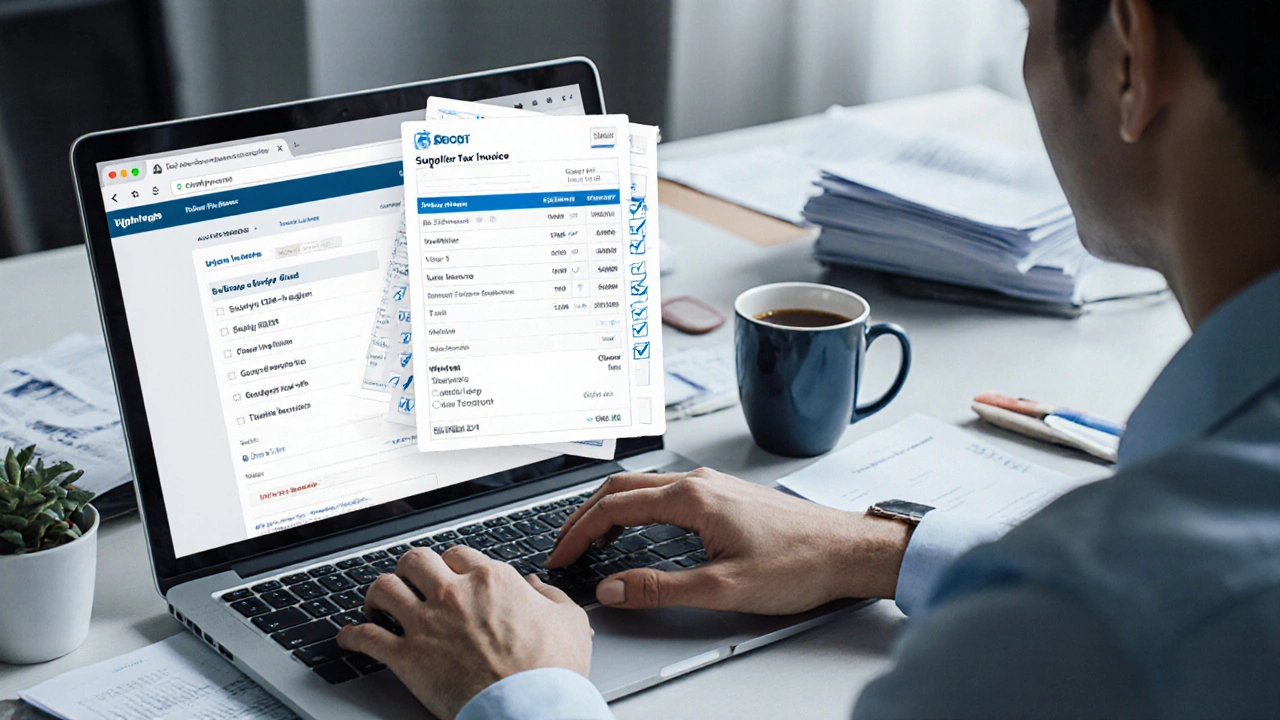GST Claim Eligibility Checker
Check Your GST Eligibility
Verify if you can claim input tax credit on purchases based on GST rules
Enter your purchase details to check eligibility.
Every business registered under GST wants to get back what they’ve paid - but not everyone knows how to claim it properly. If you’ve ever wondered why your GST refund is delayed, or why your claim got rejected, the answer usually lies in missing the basic rules. GST claims aren’t automatic. They’re earned by following strict steps, keeping the right records, and filing on time. This isn’t about loopholes or tricks. It’s about doing the work right so you actually get your money back.
What Exactly Is a GST Claim?
A GST claim is when you ask the government to return tax you’ve already paid on business purchases. This is called input tax credit (ITC). For example, if you buy raw materials for ₹10,000 and pay ₹1,800 in GST, you can claim that ₹1,800 back when you file your return - as long as you meet the rules. It’s not cash in your pocket right away. It’s a credit you use to reduce the GST you owe on your sales. If your input credit is more than what you owe, you can ask for a refund.
But here’s the catch: you can’t claim GST on everything. The law says what’s allowed and what’s not. One common mistake? Claiming GST on personal expenses - like a family vacation or your kid’s school fees - and calling it a business cost. That’s not allowed. The tax department checks these closely.
Who Can Claim GST?
Only businesses registered under GST can claim input tax credit. That means you must have a valid GSTIN - your 15-digit GST registration number. If you’re a small business under the composition scheme, you can’t claim ITC at all. That’s a trade-off: lower tax rates, but no refunds on your purchases.
Also, you must be using the goods or services for business purposes. If you buy a laptop for your office, you can claim the GST. If you buy the same laptop for your child to do homework, you can’t. The tax office looks at the purpose, not just the invoice.
The Five Rules You Must Follow
There are five non-negotiable rules for claiming GST. Break any one, and your claim gets blocked.
- You must have a valid tax invoice. The invoice must include your GSTIN, the supplier’s GSTIN, the tax amount, and the HSN code for the product. No invoice? No claim. Even if you paid cash, you still need a proper invoice.
- The supplier must have filed their return. This is the biggest surprise for many businesses. Even if you have the invoice, if your supplier didn’t file GSTR-1 on time, you can’t claim the credit. The system matches your claim with their filing. If they’re late, you’re stuck.
- You must receive the goods or services. You can’t claim GST just because you paid. You must have actually received the item or service. For example, if you paid for 100 units of parts but only got 80, you can only claim ITC on the 80.
- You must file your GST return on time. If you miss the deadline for GSTR-3B or GSTR-1, you lose the right to claim credit for that month. There’s no second chance. The system shuts the door after the due date.
- The goods or services must be used for business. No personal use. No exempt supplies. No construction of immovable property (unless it’s for your business office). Even if you have the invoice, if the use is wrong, the claim is invalid.
What You Can’t Claim GST On
There are specific items the law says you can’t claim, even if you have an invoice. These are called blocked credits.
- Motor vehicles (unless you’re in transport or car rental business)
- Food and beverages (including office canteen meals)
- Membership fees for clubs
- Outdoor catering
- Goods lost, stolen, or destroyed
- Personal use of goods - even if bought by the company
- Construction of immovable property (except for plant and machinery)
These rules are strict. There are no exceptions. Even if your accountant says it’s fine, if the law says no, you’re at risk of a notice - and having to pay back the credit with interest.
How to Claim GST: The Step-by-Step Process
Here’s how it works in practice:
- Collect all tax invoices from suppliers. Keep them in order by month.
- Match them with your supplier’s GSTR-1. Use the GST portal’s auto-populated ITC summary.
- Check if the supplier has filed their return. If not, follow up with them.
- Only claim credit for goods/services you’ve received.
- File GSTR-3B by the 20th of the next month. The system will auto-calculate your ITC.
- If your ITC is more than your output tax, go to GSTR-3B and select ‘Refund of excess ITC’.
- File Form RFD-01 for refund. Attach bank details and supporting documents.
Most businesses get their refund in 60 days if everything is in order. But if there’s a mismatch, the system holds the claim. That’s why checking supplier filings monthly is so important.
Common Mistakes That Delay Refunds
Here are the top five errors businesses make - and how to avoid them:
- Missing invoices. Keep digital and physical copies. Use cloud storage. One lost invoice can block your entire claim.
- Wrong HSN codes. If your supplier uses the wrong code, your claim might get flagged. Always verify the code on the invoice matches the product.
- Waiting until the last minute. If your supplier files late, you can’t claim. Don’t wait. Check the GST portal weekly.
- Claiming for exempt supplies. If you sell tax-free goods (like milk or books), you can’t claim ITC on purchases related to those sales.
- Not reconciling GSTR-2B. This auto-generated statement shows your ITC eligibility. Always compare it with your books before filing.

What Happens If You Claim Wrongly?
Claiming GST you’re not entitled to is serious. The tax department can:
- Recover the amount with 18% interest per year
- Impose a penalty of up to 100% of the wrong claim
- Block your ITC for future months
- Start a formal audit
Many businesses get caught because they assume ‘everyone does it.’ But the GST system is linked. Every invoice is tracked. Every supplier’s return is checked. There’s no hiding.
If you realize you made a mistake, file a voluntary correction in your next return. It’s better than waiting for the department to find it.
Pro Tips for Smooth GST Claims
- Use accounting software that auto-matches invoices with GSTR-2B. Tools like Tally, Zoho Books, or Khatabook help reduce errors.
- Set a monthly reminder to check your supplier’s filing status on the GST portal.
- Keep a separate ledger for ITC claims - don’t mix it with your general expenses.
- Train your accounts team on the five rules. One mistake by one person can cost the whole business.
- If you’re unsure, consult a GST practitioner before filing. A ₹500 consultation can save you ₹50,000 in penalties.
When Can You Get a Refund?
You get a refund when your input tax credit exceeds your output tax liability. This happens often with:
- Exporters (zero-rated supplies)
- Businesses with high purchase costs and low sales (like manufacturers)
- Startups with heavy initial investments
The refund process takes up to 60 days from the date you file Form RFD-01. If it’s delayed beyond that, you get interest at 6% per year. You can track your refund status on the GST portal under ‘Refund Status’.
Don’t expect a refund every month. Sometimes, your output tax is higher than your input credit. That’s normal. You’re just paying tax - not getting money back. The goal is to balance it over time.
Can I claim GST on office rent?
Yes, you can claim GST on office rent if you’re registered under GST and the rent is for business use. The landlord must issue a valid tax invoice with your GSTIN. If the rent is for a residential property, you can’t claim it.
What if my supplier didn’t file GSTR-1?
You cannot claim input tax credit until your supplier files their GSTR-1. The system won’t match your claim. Follow up with them immediately. If they’re consistently late, consider switching suppliers or adjust your cash flow planning.
Can I claim GST on travel expenses?
Only if it’s for business travel and you have a valid invoice. Airfare and train tickets with GST are claimable. But personal trips, cab rides without invoice, or hotel stays under ₹5,000 per night (if not for business meetings) are not allowed.
Is there a time limit to claim GST credit?
Yes. You must claim ITC by the due date of the September return of the next financial year - or the date of filing your annual return, whichever comes first. For example, for April 2024 invoices, you have until September 2025 to claim. After that, the credit is lost forever.
Can I claim GST on old invoices from last year?
Only if you haven’t passed the deadline. For invoices from FY 2023-24, the last date to claim was September 2025. If you missed it, you can’t claim it anymore. The system doesn’t allow retroactive claims.



